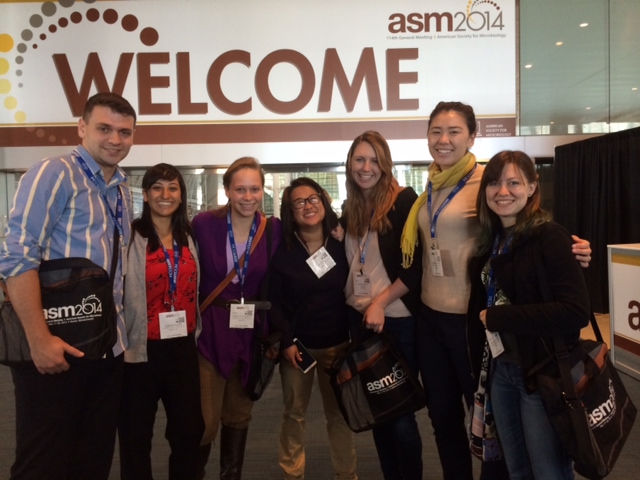A group of us from Jonathan Eisen’s lab attended the General Meeting for the American Society for Microbiology (ASM) last month in Boston. A major highlight of the conference was “We Are Not Alone: Microbial Revelations of the Built Environment,” a symposium that was organized by the Junior Advisory Group that is made up of postdocs and junior faculty to promote new hot science at ASM. The symposium was convened by Filipa Godoy-Victorino (Inter American University of Puerto Rico) and Sarah Pacocha Preheim (MIT). ASM made this promotional piece for the symposium.
This symposium had an impressive line up of speakers. James Meadow (University of Oregon, BioBE) discussed recent findings on the microbiome of classrooms and the personal microbiome of cell phones. Mark Hernandez (University of Colorado, Boulder) spoke about using real time optical methods to characterize airborne microbes. In her talk entitled Microbes Across Human Cultures, Maria Gloria Dominguez-Bello (New York University) spoke on an interdisciplinary study comparing the microbiome of buildings across a transcultural gradient, ranging from a traditional village in the Amazon to the city of Manaus (that is now hosting the World Cup). I particularly enjoyed the animated architectural reconstructions of each of the sixty houses with sample sites indicated. James Scott (University of Toronto) presented a network analysis on the microbiome of indoor air and dust. Otto Schwake (Arizona State University) presented findings on a study on Legionella in windshield wiper fluid in cars and school buses. Jennifer Fouquier (San Diego State University) described her analysis of the fungal microbiome of public restrooms using the internal transcribed spacer. And Christa Gomez-Smith (University of Colorado, Boulder) gave a fascinating talk entitled “There’s something in the pipes” with amazing photos on tuberculated surfaces in water pipes.
I hope to see more symposia like this for years to come at ASM.

I also enjoyed that symposium very much. Thank you for reminding me of that wonderful session. I was particularly impressed with the optical method Mark Hernandez is developing to characterize airborne microbes. I find this a promising technology with a wide range of potential applications that can advance the state of the science as well as many practical applications for professionals and building investigators. I hope we will learn more about this and others will find uses for it in their own work. I can envision comparisons with other methods and an expansion of the number of organisms for which it can be used. Currently, it certainly can be used as a screening tool to identify locations of strong sources or for those microbes Hernandez’s lab has already confirmed it can correctly identify.
There were very few other papers or presentations that connected the built environment to the microbes found at ASM other than at that symposium. I was disappointed that there weren’t more since that is my own interest and reason for attending ASM.
There was an interesting poster on the history of tuberculosis, probably transmitted primarily through the air and indoors.
There was a poster by a researcher from EPA in Cininatti who analyzes sludge samples sent to him by contractors who clean water tanks. The investigator identifies the microbes found in the samples and reported the occurrence of what he finds there. Legionella p. and Pseudomonas spp. were the most commonly found microbes in the sludge from water tanks. I asked if he knew the pH of the water and someone else asked if he knew the chlorine content; the answer was a disappointing “no” to both. I don’t quite understand the point of doing this work if it is not related to the relevant environmental influences on what is found, but that’s just my perspective.
There was also a disappointing poster about the molds that grow on wet wood, which is very well-documented already in the literature. I thought the poster added little or nothing to the existing published knowledge and was surprised at the presenter’s lack of familiarity with the literature. How can this happen?
Holly: I would be curious to know what you thought were the most important things learned at the symposium about the relationship between the built environment and the indoor microbiome? Thanks in advance for sharing that with readers of this blog.
Hello,
We’d like to use your photo in one of our brochures, but need your permision. Would you email me at cgiles@asmusa.org?